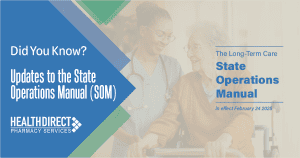CDC Recommendations:
Per the CDC National Center for Immunization and Respiratory Diseases (NCIRD), the following practices should be considered when SARS-CoV-2 and Influenza viruses are found to be co-circulating based upon local public health surveillance data and testing at local healthcare facilities. While these considerations are specific to care of residents residing in nursing homes, some practices could be adapted for use in other long-term care settings (e.g. assisted living communities).
The CDC recommends annual influenza vaccination for all people aged 6 months and older as the first and most important tool to prevent influenza. Similarly, the CDC encourages all residents and healthcare providers to remain up to date with recommended COVID-19 vaccine doses.
- Place symptomatic residents in transmission-based precautions using all recommended PPE for care of a resident with suspected SARS-CoV-2 Infection-
- Test any resident with symptoms of COVID-19 or influenza for both viruses-
- Due to the possibility of co-infection with influenza and COVID-19, testing positive for one virus does not rule out co-infection with the other.
- Clinical Management Considerations; Influenza and SARS-CoV-2
All long-term care facility residents who have confirmed or suspected influenza should receive antiviral treatment as soon as possible, while test results are pending for symptomatic residents.
Four influenza antiviral drugs approved by the U.S. Food and Drug Administration are recommended for
treatment of influenza in the United States: neuraminidase inhibitors: oral oseltamivir (available as a generic version or under the trade name Tamiflu®), as a pill or suspension; zanamivir (trade name Relenza®), available as an inhaled powder using a disk inhaler device; and intravenous peramivir (trade name Rapivab®); and a cap-dependent endonuclease inhibitor: baloxavir marboxil (trade name Xofluza®) available as a tablet. These antivirals should be started within 48 hours of symptom onset.
Antiviral Adult Dosing – Influenza Treatment:
| Medication | Dosage | Considerations for Use |
|---|---|---|
| Preferred Medications | ||
| Oral oseltamivir (Tamiflu) 30 mg capsule 45 mg capsule 75 mg capsule 6 mg/ml oral suspension | Adults: 75 mg PO twice daily x 5 days | CrCl more than 60 mL/minute: No dosage adjustment necessary. CrCl 31 to 60 mL/minute: 30 mg PO twice daily for 5 days. CrCl 11 to 30 mL/minute: 30 mg PO once daily for 5 days. CrCl 10 mL/minute or less, not undergoing dialysis: Oseltamivir is not recommended. ESRD on hemodialysis: 30mg after every hemodialysis cycle, treatment not to exceed 5 days. |
| Alternative Medications | ||
| Inhaled zanamivir (Relenza) 5 mg powder for inhalation | Adults: 10 mg (two 5 mg inhalations) every 12 hours x 5 days | Contraindicated for patients that have an allergy to milk protein lactose, used as a vehicle. Caution advised for patients with high-risk underlying medical conditions, including elderly patients, severe metabolic disease and long or cardiac disease due to limited data on use in these populations. Not recommended for use with chronic pulmonary diseases due to an increased risk of bronchospasm. |
| Intravenous peramivir (Rapivab) 200mg / 20 ml solution for injection | Adults: One 600 mg / 100 ml dose infused IV over 15-30 minutes | CrCl 50 mL/minute or more: No dosage adjustment necessary. CrCl 30 to 49 mL/minute: 200 mg IV as single dose. CrCl 10 to 29 mL/minute: 100 mg IV as single dose. Post marketing reports include risk for serious skin reactions and sporadic, transient neuropsychiatric adverse events (i.e. psychosis). |
| Oral baloxavir marboxil (Xofluza) 20 mg tablet 40 mg tablet 80 mg tablet | Adults weighing 80 kg or more: 80 mg PO x 1 dose Weight < 80 kg: 40 mg PO x 1 dose | Avoid co-administration of baloxavir with polyvalent cation-containing laxatives, antacids, or oral supplements (e.g., calcium, iron, magnesium, selenium, or zinc), may decrease absorption and efficacy. Not recommended during pregnancy, lactation, or for use in severely immunocompromised patients. |
It should be noted that some long-term care residents may have difficulty using the inhaler device for zanamivir.
There is no data on the use of baloxavir to control influenza outbreaks in long-term care facilities. IV peramivir is a reserved treatment option for those that cannot take oral oseltamivir or tolerate inhaled zanamivir. For these reasons, oseltamivir (Tamiflu) remains the preferred treatment option, unless an oseltamivir-resistant flu strain is suspected.
Antiviral Chemoprophylaxis – Influenza:
Administering chemoprophylaxis to reduce impact of an influenza outbreak in the long-term care community is recommended for the following individuals:
- All members of a unit if at least 2 residents are ill with lab-diagnosed influenza within 72 hours of each other, regardless of vaccination status.
- Individual residents if they were exposed to an influenza positive individual within the last 48 hours.
- All residents if mixing of residents or healthcare personnel from affected units is unavoidable.
- Healthcare personnel may be considered based on occupational exposure and other risk factors.
During an outbreak, antiviral chemoprophylaxis is recommended for a minimum of 14 days and should continue at least 7 days after the last known laboratory-confirmed influenza case is identified.
Oseltamivir is the preferred agent for antiviral prophylaxis in long-term care settings and should be used whenever possible. If an oseltamivir-resistant flu strain is suspected, inhaled zanamivir may be used.
Antiviral Adult Dosing- Influenza Chemoprophylaxis:
| Medication | Dosage | Considerations for Use |
|---|---|---|
| Preferred Medications | ||
| Oral oseltamivir (Tamiflu) 30 mg capsule 45 mg capsule 75 mg capsule 6 mg/ml oral suspension | Adults: 75 mg PO ONCE daily x 14 days | CrCl more than 60 mL/minute: No dosage adjustment necessary. CrCl 31 to 60 mL/minute: 30 mg PO once daily x 14 days. CrCl 11 to 30 mL/minute: 30 mg PO every other day x 14 days. CrCl 10 mL/minute or less, not undergoing dialysis: Oseltamivir is not recommended. ESRD on hemodialysis: 30 mg after alternate hemodialysis cycles, for a total duration of 14 days. |
| Alternative Medications | ||
| Inhaled zanamivir (Relenza) 5 mg powder for inhalation | Adults: 10 mg (two 5 mg inhalations) every 24 hours x 14 days | Contraindicated for patients that have an allergy to milk protein lactose, used as a vehicle. Not recommended for use with chronic pulmonary diseases due to an increased risk of bronchospasm. Should only be considered if an oseltamivir-resistant flu strain is suspected or confirmed. |
*Baloxavir is FDA approved for post-exposure prophylaxis for persons aged 5 years and older, however due to a lack of data in the LTC population, is not recommended. Dosing for chemoprophylaxis is weight based and the same as described above for treatment.
Guidance for Prioritization when Antiviral Supplies are Limited:
The CDC has issued guidance via the Health Alert Network (HAN) that supply shortages of generic oseltamivir (Tamiflu) have already been reported during the 2022-2023 flu season.
A limited duration treatment dosage (i.e., twice daily for 5 days) for post-exposure oseltamivir instead of extended use of oseltamivir chemoprophylaxis (once daily for 14 days), with ongoing active daily monitoring and influenza testing for all residents with new illness signs and symptoms, may be considered to reserve antiviral supply.
Your HealthDirect Pharmacy will communicate any disruptions in oseltamivir supply that may impact antiviral treatment options throughout the course of the flu season.
Confirmed SARS-CoV-2 Infection; Treatment Options:
Antiviral therapy options are available and recommended by the NIH for management of COVID-19 infection to reduce the risk of progressing to severe disease, hospitalization, and death. Older adults and those with underlying medical conditions are at a higher risk for developing serious disease and related adverse outcomes, and should be considered for treatment as soon as infection is confirmed.
The following table describes currently recommended treatment options for non-hospitalized adults in order of preference per the NIH COVID-19 Treatment Guidelines.
| Drug Name | Dosing Regimen | Time from Symptom Onset | Considerations for Use |
|---|---|---|---|
| Preferred Therapies | |||
| Nirmatrelvir-ritonavir (Paxlovid) | eGFR ≥60 mL/min: • 300mg (2 tablets) nirmatrelvir and 100mg (1 tablet) ritonavir PO twice daily for 5 days eGFR ≥30 to <60 mL/min: • 150mg nirmatrelvir (1 tablet) and 100mg ritonavir (1 tablet) PO twice daily for 5 days eGFR <30 mL/min: • Not recommended Severe Hepatic Impairment (Child-Pugh Class C): • Not recommended | ≤5 days | Ritonavir is a strong CYP3A4 and P-GP inhibitor, resulting in significant drug interactions. Clinicians should consider all concomitant medications and consult Pharmacy for management recommendations. |
| Remdesivir (Veklury) | Adults and pediatrics weighing at least 40kg: 200mg IV on day 1 followed by 100mg IV on days 2 and 3. Each infusion is administered over 30–120 minutes. Patients should be observed for ≥1 hour after infusion as clinically appropriate. Longer infusion times may reduce risk of hypersensitivity. | ≤7 days | Remdesivir is not recommended in patients with eGFR < 30 ml/min. Renal and hepatic function, as well as prothrombin time should be evaluated before starting Veklury and as clinically indicated during treatment. |
| Alternative Therapies | |||
| Molnupiravir (Lagevrio) | Adults: 800 mg (four 200 mg capsules) taken orally every 12 hours for 5 days | ≤5 days | Molnupiravir is not authorized for use in patients less than 18 years of age because it may affect bone and cartilage growth. Not recommended during pregnancy or breastfeeding due to toxicity concerns. Hypersensitivity reactions have been reported during post-marketing surveillance. |
*Dexamethasone and other systemic corticosteroids are not recommended to treat outpatient COVID-19 unless patient requires supplemental oxygen, or hospitalization. Patients that require corticosteroids for management of underlying medical conditions should continue corticosteroid as directed by clinician.
The treatment guidelines currently recommend against using anti-SARS-CoV-2 monoclonal antibody products (i.e., bebtelovimab) for the treatment of COVID-19 because the dominant Omicron subvariants in the United States are no longer expected to be susceptible to these products.
For all patients, symptomatic management with antipyretics, analgesics or antitussives for fever, headache, myalgias and cough is recommended.
Co-Infection Considerations: Influenza and SARS-CoV-2:
- Antiviral treatment for influenza is the same for all patients regardless of SARS-CoV-2 co-infection.
- With limited data available on treating co-infection, the panel states there are no clinically significant drug interactions between the antiviral agents or immunomodulators that are used to prevent or treat
COVID-19 and the antiviral agents that are used to treat influenza.
- Confirmed SARS-CoV-2 infection should be managed according to the latest treatment recommendations from the NIH COVID-19 therapeutic management guidelines.
- Treatment should be administered as soon as possible for nursing home residents with mild-to-moderate COVID-19 because they are at high risk of progression to severe COVID-19.
- Follow infection control protocols to reduce transmission, provide symptom management and supportive care to all patients.
The document is intended to serve as a summary of current recommendations from the CDC and NIH and is considered accurate at time of publication. Review the articles referenced below for up to date information and recommendations.
References:
- Centers for Disease Control and Prevention. “Testing and Management Considerations for Nursing Home Residents with Acute Respiratory Illness Symptoms when SARS-CoV-2 and Influenza Viruses are Co-circulating.” 22 Nov. 2022, https://www.cdc.gov/flu/professionals/diagnosis/testing-management-considerations-nursinghomes.htm Accessed 20 Dec. 2022.
- Centers for Disease Control and Prevention. “Interim Guidance for Influenza Outbreak Management in Long-Term Care and Post-Acute Care Facilities”. 21 Nov. 2022. https://www.cdc.gov/flu/professionals/infectioncontrol/ltc-facility-guidance.htm Accessed 21 Dec. 2022.
- Infectious Disease Society of America. “Clinical Practice Guidelines by the Infectious Diseases Society of America: 2018 Update on Diagnosis, Treatment, Chemoprophylaxis, and Institutional Outbreak Management of Seasonal Influenza” 5 Mar. 2019, https://academic.oup.com/cid/article/68/6/895/5369363 Accessed 20 Dec. 2022.
- Centers for Disease Control and Prevention. “Influenza Antiviral Medications: Summary for Clinicians” 9 Sep. 2022, https://www.cdc.gov/flu/professionals/antivirals/summary-clinicians.htm Accessed 20 Dec. 2022
- National Institute of Health. “Therapeutic Management of Nonhospitalized Adults With COVID-19” 28 Dec. 2022. https://www.covid19treatmentguidelines.nih.gov/management/clinical-management-of-adults/nonhospitalized-adults–therapeutic-management/
Accessed 28 Dec. 2022. - Clinical Pharmacology Monographs. https://www.clinicalkey.com/pharmacology/monograph/5378?sec=monindi Subscription required to view.




